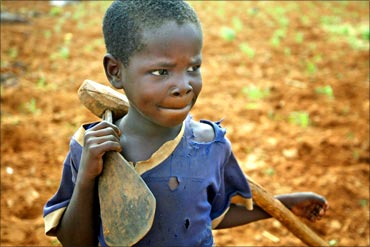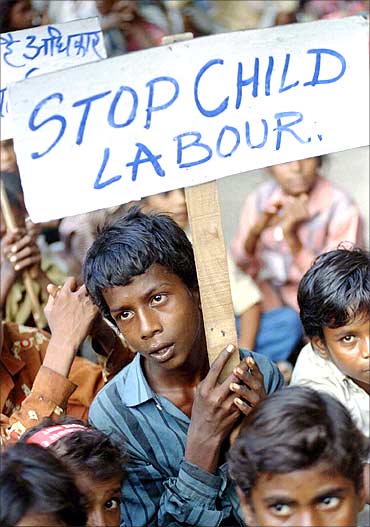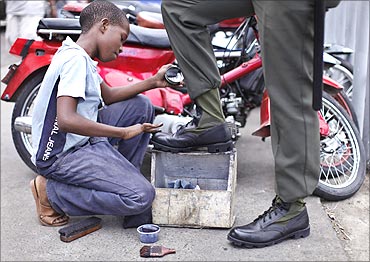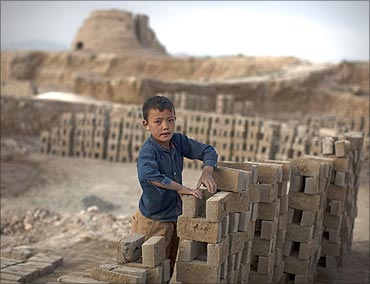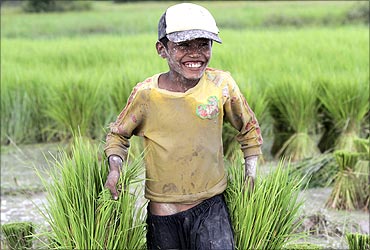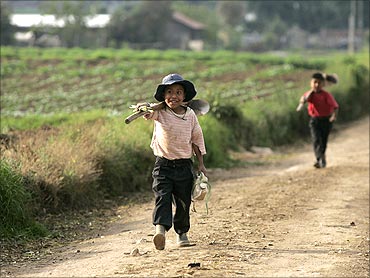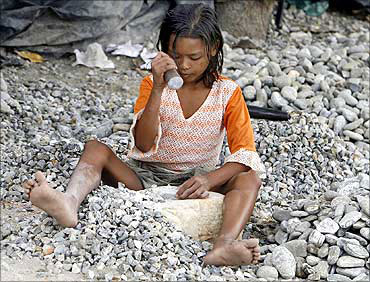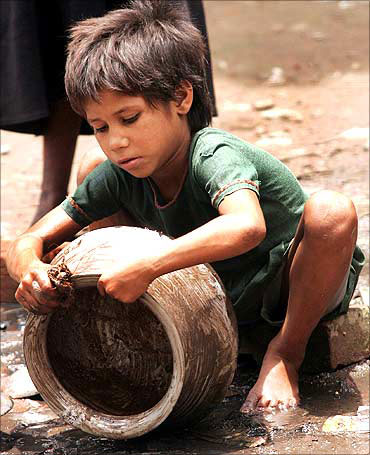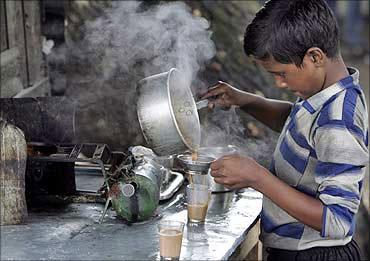 | « Back to article | Print this article |
MUST READ: Some harsh truths about child labour
While doing a series on child labour recently, rediff.com was confronted with some harsh realities.
The entire experience was a sad eye-opener.
It pains to think that all over the world, children continue to work, putting at stake their education, their health, their normal development to adulthood, and even their lives.
Millions of them even work under hazardous conditions which present dangers to their health, safety and welfare.
Around 215 million children across the world are still trapped in child labour, according to the International Labour Organisation study.
We present here some dark truths on this vexing issue.
Read on. . .
Source: International Labor Organization data, World Bank statistics and agencies
Click NEXT to read further. . .
MUST READ: Some harsh truths about child labour
December 2 was the International Day for the Abolition of Slavery.
That day recalled the date of the adoption of the United Nations Convention for the Suppression of the Traffic in Persons and of the Exploitation of the Prostitution of Others (resolution 317(IV)of 2 December 1949) by the UN General Assembly.
Child labour, along with trafficking of people, is the worst form of slavery known to mankind.
The economic exploitation of children is an insult to humanity, says the World Bank.
Yet the world, it seems, has turned blind and deaf.
Click NEXT to read further. . .
MUST READ: Some harsh truths about child labour
What is child labour
Child labour means employing a child who is under the age specified by law.
The word 'work' means full time commercial work to sustain self or add to the family income.
Any child who is employed in activities to feed himself and his family is being subjected to child labour.
A child working part time (3-4 hours) to learn and earn for self and parents after school, is not considered child labour.
Click NEXT to read further. . .
MUST READ: Some harsh truths about child labour
Reasons for child labour
There are many reasons for child labour. These are:
- poverty;
- unemployment;
- non-implementation of government-declared minimum wages;
- parental illiteracy;
- general acceptance of the society when it comes to child labour;
- ignorance;
- lack of education and exposure;
- exploitation of cheap and unorganised labour;
- prevalence of bonded labour;
- lack of land reform in most Indian states, et cetera.
Children, who are rag-pickers, beggars, street sellers, street entertainers, child prostitutes, mostly without natural guardians, are exploited by gangsters and racketeers.
These kids are mostly illegal migrants.
Click NEXT to read further. . .
MUST READ: Some harsh truths about child labour
In Asia, there are 153 million child labourers
According to ILO figures, in Latin America and Caribbean, there are 17 million child labourers, in Africa the number is 18 million, in Asia it is 153 million and in Oceania it is 0.5 million.
ILO states that there are some 250 million children between the ages of 5 and 14 years who are in economic activity in developing countries alone.
For 120 million of them, work is a full-time activity.
The remainder combines work with schooling or other non-economic activities.
Africa comes first in the proportion of children participating in economic activity, with an estimated 41 per cent of the total number of children aged between five and 14 compared to 22 per cent in Asia and 17 per cent in Latin America.
Click NEXT to read further. . .
MUST READ: Some harsh truths about child labour
Most children are in agriculture-related work
The largest proportion of child workers is in economic activities and occupations related to agriculture.
Although the average proportion of children in agricultural activities and occupations is 70 to 74 per cent, it can be as high as 90 to 95 per cent in some countries.
The percentage of girls in such activities is higher than that of boys.
A large number of children suffer injuries or illnesses from their work . representing more than 20 per cent according to one recent large national survey.
Some stop work altogether due to work-related injuries and/or illnesses or stop work temporarily, while a large number continue to work in spite of their injuries or illnesses, thus jeopardising their development and future ability to study or work.
Many children work long hours every day of the week.
Click NEXT to read further. . .
MUST READ: Some harsh truths about child labour
Agriculture work most hazardous
Agriculture is one of the three most hazardous work sectors -- along with mining and construction -- in terms of work-related deaths and injuries.
This is especially true for children, whose lack of experience or training and still-developing bodies make them particularly vulnerable, says a Food and Agriculture Organization study.
In 2008, Apple found that a total of 25 child workers had been employed to build iPods, iPhones and its range of computers.
Click NEXT to read further. . .
MUST READ: Some harsh truths about child labour
Other blatant truths
- Many of the child labourers are enslaved in bonded labour, isolated in domestic service, and traumatised and abused in the commercial sex trade, says a World Bank study.
- About 10 million children are engaged in child labour in Pakistan out of which 50 per cent are between 5 and 7 years of age.
- The Sub-Saharan African region has the highest share of child labourers.
- In 18 countries in this region, 38 per cent of all children between 7 and 14 years of age are engaged in work that is harmful to their development.
- About 70 per cent of child labourers worldwide are found in agriculture, with many children engaged in forced and hazardous activities.
- ILO estimates indicate that 129 million girls and boys, aged 5-17, are still working in this sector.
- Child labour has risen in Afghanistan due to ongoing political tensions, war and terrorism.
- With high poverty rates, Guatemala has a large number of child workers. On an average, Guatemalan children contribute 30 per cent of their family's annual income.
Click NEXT to read further. . .
MUST READ: Some harsh truths about child labour
Can child labour be abolished?
- It would cost $760 billion over a 20-year period to end child labour. The estimated benefit in terms of better education and health is about six times that -- over $4 trillion in economies where child labourers are found.
- Some children are forced to work up to 18 hours a day, often never leaving the confines of the factory or loom shed.
- Children trafficked into one form of labour may be later sold into another, as with girls from rural Nepal, who are recruited to work in carpet factories but are then trafficked into the sex industry over the border in India.
- More than half of the 14-year old children in Cambodia are forced to work to support their poor families.
- Despite terrible living conditions and the fear of being sent back to their country, several hundred illegal immigrants from Myanmar live and earn an average of $1 per day collecting plastic at rubbish dumps.
Click NEXT to read further. . .
MUST READ: Some harsh truths about child labour
Indian scenario
It is estimated that there are over 6 crore (60 million) child labourers in India.
Uttar Pradesh has the highest number of child labourers in India, while Andhra Pradesh's figure stands at 13.63 lakh (1.363 million).
An estimated 14 per cent of children in India between the ages of 5 and 14 are engaged in child labour activities, including carpet production.
The most inhuman form of child exploitation is the age old practice of bonded labour in India.
Here children are sold to the buyer like a commodity for a certain period of time.
The labour that the child is subjected to is treated as collateral security and exploiters 'buy' them for small sums at exorbitant interest rates.

